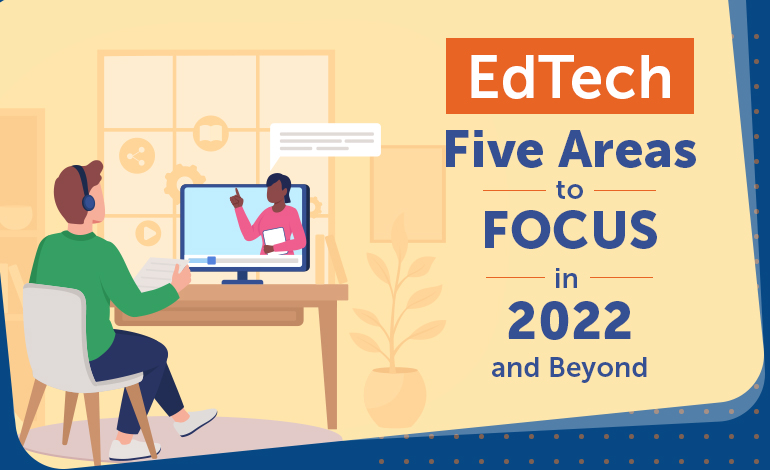EdTech: Five Areas to Focus in 2022 and Beyond
Venture capital in the EdTech industry has grown exponentially since 2010. It was $16.1 billion in 2020, but by 2022, the industry has attracted close to $50 billion in funding! And though all the regions are growing, Asia makes up 80% of all global VC dollars. It’s a reflection of the growing demand for disruptive technology in education.
The past two years accelerated the change the industry was already going through and we have much more to look forward to in 2022 and beyond. Here are the five areas to focus on:
1. AI-enabled adaptive learning
AI is already being used extensively in learning curriculums. 2022 will only see an acceleration of this trend to create effective personalized and interactive learning experiences, which can help resolve most of the challenges the industry is facing today. Leveraging dynamic AI, education providers can enable learners to take hyper-personalized journeys by interpreting the interests of each student and predicting their behavior to offer them the exact content that they need.
For instance, Singapore-based Vere360 uses AI and VR to offer quality education for social issues and skills development. The platform partners with several knowledge partners to build content easily accessible through a VR education app. Other examples include:
>> Smart Sparrow, whose adaptive learning platform adapts through modules and offers interactive quizzes and simulations.
>> IBM Research, in association with Skillsoft, launched an adaptive learning pilot program to offer adaptive data over user-content interactions, content relationships, and consumption patterns.
2. Gamification
Gamification isn’t new; it has been in use in classrooms and corporate board rooms for years with numerous hackathons and coding challenges. In 2022, however, gamification is bound to become a mainstay with the domination of the Metaverse. Most of the learners across the corporate world and students at all levels are digital natives and already have high expectations of digital applications. This year would see elements in the EdTech companies’ strategies, where learners can create their own content and collaborate. Even educators will use resources created by game designers, giving students sufficient challenges to keep them interested.
For instance, Brainscape has customized gamification through flashcards with an extensive list of topics, where learners can create their own cards or ask the program to make the cards for them. Another famous example is Duolingo – the language learning app, where lessons are grouped in skills, and they gradually teach you vocabulary and phrases. Learners can choose daily goals, and a notable element is their “Immersion area,” which lets you practice your language skills by translating texts in a special wiki-style, collaborative system.
3. Immersive learning with VR/AR
Virtual Reality (VR) and Augmented Reality (AR) technologies started in the gaming industry first before being adopted by the EdTech industry as an effective means of learning. The technologies help learners eliminate distractions and immerse themselves in their work. It’s also proven to be a very handy tool for students with ADD/ADHD. For instance, in 2022, teachers will increasingly use AR to teach students real-life lessons, like creating a tornado and bringing the funnel right into the classroom so students can experience these destructive storms close up.
Microsoft HoloLens has developed an interesting way to teach medical students and clinicians to interact and learn more about the human body using mixed reality. Learners can isolate, enlarge, and even walk inside the components of the human body to understand anatomy and learn how to treat different medical conditions.
4. Video-assisted learning
Videos – whether they are short or targeted clips – are huge already. And they have some proven benefits to different aspects of learners’ development and educational progress. 2022 will see more enhancements in video-assisted learning not just as a learning pedagogy but to enhance inclusivity and cultural awareness.
Teachers will use educational technologies, like whiteboards, to make their lessons varied, dynamic, and interactive. EdTech companies will increasingly use video clips or short videos to bring up a new discussion point in their courses, rather than just uploading videos on platforms for learners to watch later.
5. Learning flexibility
2022 is also going to be the year for flexibility in learning. Technology has made our lives enriching and the same flexibility will come to learning content as well. In 2021, we spoke about the end of the 9-5 routine. Gone will be the days when there will be fixed one-or two-year academic programs. With the advent of more streamlined virtual learning tools and video conferencing, learners will be able to pursue education when, where, and at the pace that suits them best.
Higher and professional education is leveraging technology to break from the routine timelines. For instance, Birmingham Business School recently introduced its 100% online MBA program that can be completed in anything from two-and-a-half to five years. This flexibility also has a name – the hybrid-flexible model, or HyFlex, defined as simultaneously hybrid instruction (a combination of online and face-to-face), and flexible. Learners can choose to attend face-to-face or learn online.
While in 2022
2022 is an exciting year for EdTech, thanks to organizations and educators for leveraging a connected world and delivering media-rich, student-centric solutions to help learners across the globe. But as the methodologies become more accessible and interactive, technologies and expertise need to keep up with the learners’ growth aspirations. A reliable digital learning partner can help with that.
Liqvid has two decades of eLearning design and delivery experience across instructional design methodologies, content authoring tools, and learning management systems. We are the partner of choice for several reputed EdTech and extended enterprise training providers—helping them take their programs to market faster in the most efficient way. Our approach is to create personalized learning experiences for every user of the digital learning programs we deliver for our clients. We have developed hundreds of interactive templates, AI tools, and learning apps that enable our clients to hit the ground running in this fast-paced EdTech market. Contact us!


